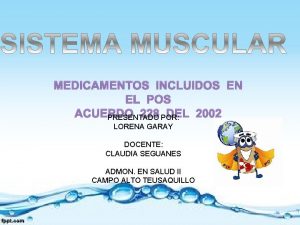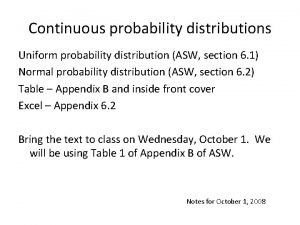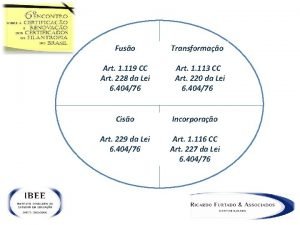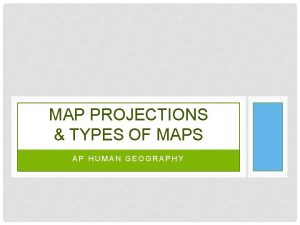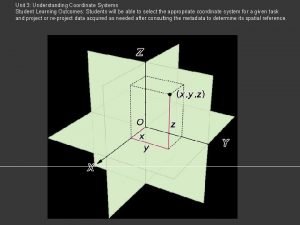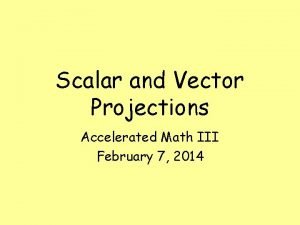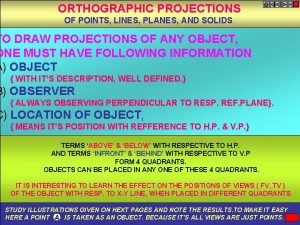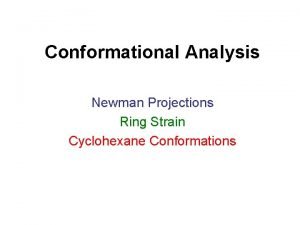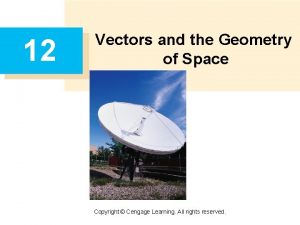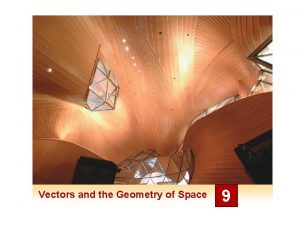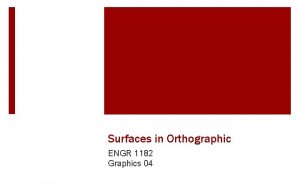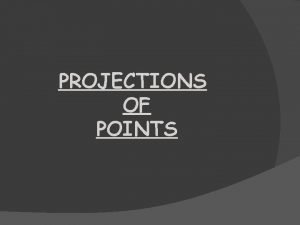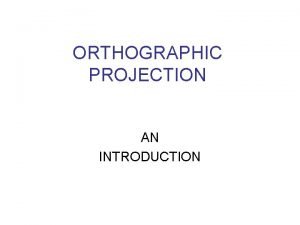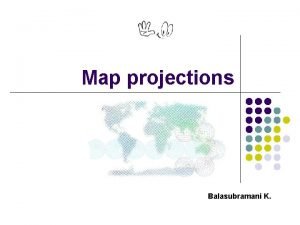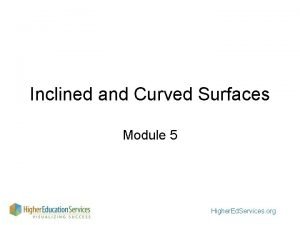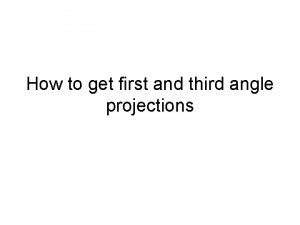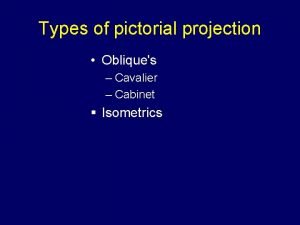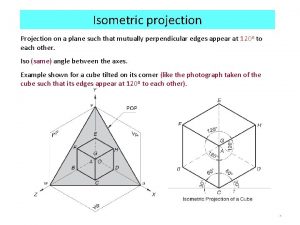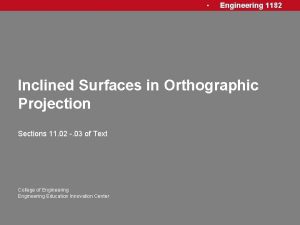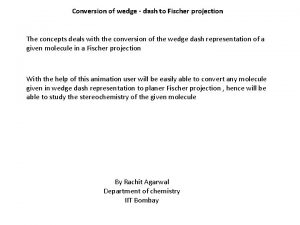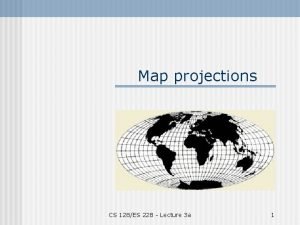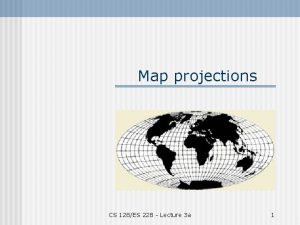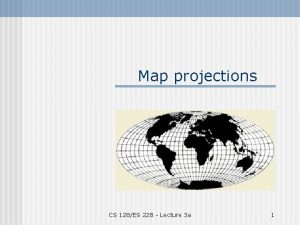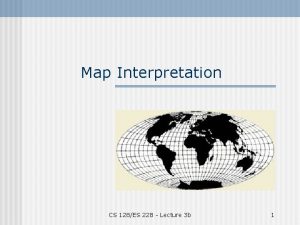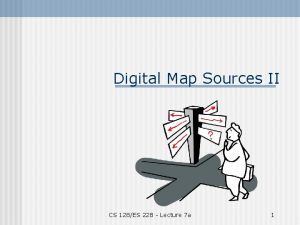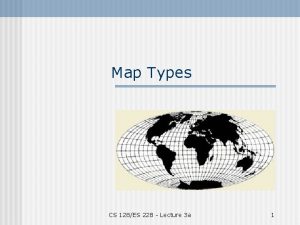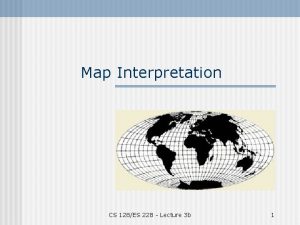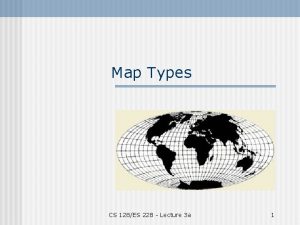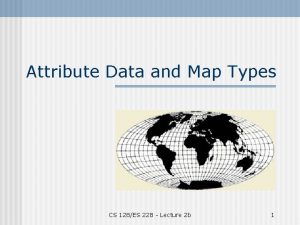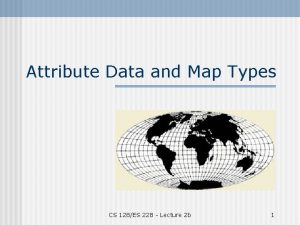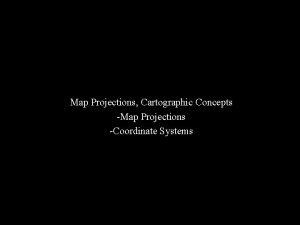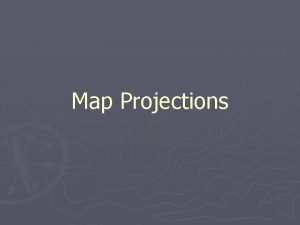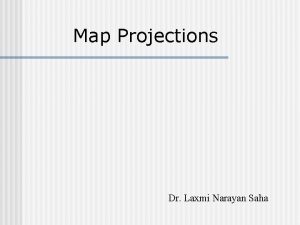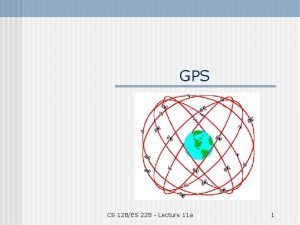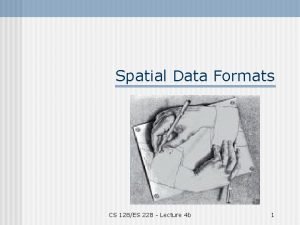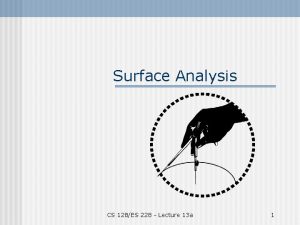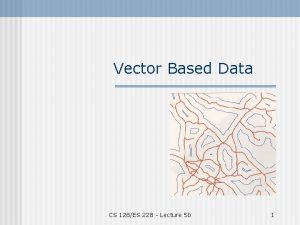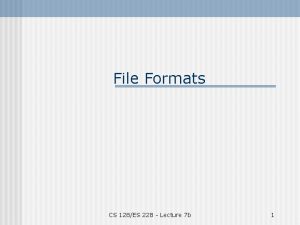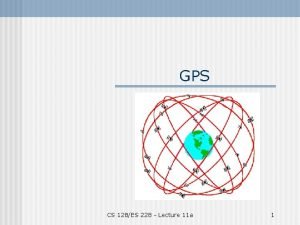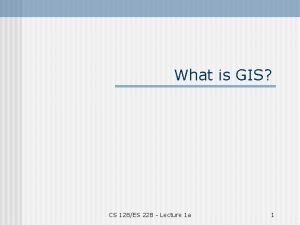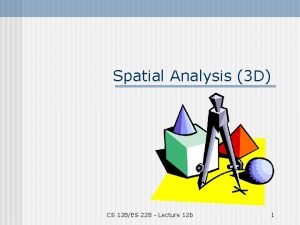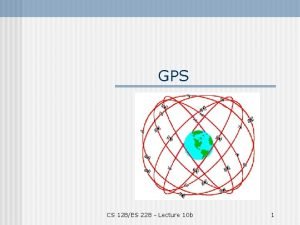Map projections CS 128ES 228 Lecture 3 a




















![An early projection Leonardo da Vinci [? ], c. 1514 http: //www. odt. org/hdp/ An early projection Leonardo da Vinci [? ], c. 1514 http: //www. odt. org/hdp/](https://slidetodoc.com/presentation_image_h2/a409f38396436b68a5d53e48308f7e45/image-21.jpg)












- Slides: 33

Map projections CS 128/ES 228 - Lecture 3 a 1

The dilemma Maps are flat, but the Earth is not! Producing a perfect map is like peeling an orange and flattening the peel without distorting a map drawn on its surface. CS 128/ES 228 - Lecture 3 a 2

For example: The Public Land Survey System • As surveyors worked north along a central meridian, the sides of the sections they were creating converged • To keep the areas of each section ~ equal, they introduced “correction lines” every 24 miles CS 128/ES 228 - Lecture 3 a 3

Like this Township Survey Kent County, MI 1885 http: //en. wikipedia. org/wiki/Image: Kent-1885 -twp-co. jpg CS 128/ES 228 - Lecture 3 a 4

One very practical result http: //www. texasflyer. com/ms 150/img/rider s 05. jpg CS 128/ES 228 - Lecture 3 a 5

The Paris meridian n Surveyed by Delambre & Méchain (1792 -98) n Used to establish the length of the meter & estimate the curvature of the Earth n Paris meridian used by French as 0 o longitude until 1914 Alder, K. 2002. The measure of all things: the seven-year odyssey and hidden error that transformed the world. The Free Press, NY. Frontispiece. CS 128/ES 228 - Lecture 3 a 6

The new meridian* n In 1884, at the International Meridian Conference in Washington, DC, the Greenwich Meridian was adopted as the prime meridian of the world. France abstained. n The French clung to the Paris Meridian (now longitude 2° 20′ 14. 025″ east) as a rival to Greenwich until 1911 for timekeeping purposes and 1914 for navigation. n To this day, French cartographers continue to indicate the Paris Meridian on some maps. http: //en. wikipedia. org/wiki/Paris_Meridian * for most of the world CS 128/ES 228 - Lecture 3 a 7

Geographical (spherical) coordinates Latitude & Longitude (“GCS” in Arc. Map) § Both measured as angles from the center of Earth § Reference planes: - Equator for latitude - Prime meridian (through Greenwich, England) for longitude CS 128/ES 228 - Lecture 3 a 8

Lat/Long. are not Cartesian coordinates n They are angles measured from the center of Earth n They can’t be used (directly) to plot locations on a plane Understanding Map Projections. ESRI, 2000 (Arc. GIS 8). P. 2 CS 128/ES 228 - Lecture 3 a 9

Parallels and Meridians Parallels: lines of latitude. Meridians: lines of longitude. § Everywhere parallel § 1 o always ~111 km (69 miles) § Some variation due to ellipsoid (110. 6 at equator, 111. 7 at pole) § Converge toward the poles § 1 o =111. 3 km at 0 o = 78. 5 “ at 45 o = “ at 90 o CS 128/ES 228 - Lecture 3 a 0 10

The foundation of cartography 1. Model surface of Earth mathematically 2. Create a geographical datum 3. Project curved surface onto a flat plane 4. Assign a coordinate reference system (leave for next lecture) CS 128/ES 228 - Lecture 3 a 11

1. Modeling Earth’s surface n Ellipsoid: theoretical model of surface - not perfect sphere - used for horizontal measurements n Geoid: incorporates effects of gravity - departs from ellipsoid because of different rock densities in mantle - used for vertical measurements CS 128/ES 228 - Lecture 3 a 12

Ellipsoids: flattened spheres n n Degree of flattening given by f = (a-b)/a (but often listed as 1/f) Ellipsoid can be local or global CS 128/ES 228 - Lecture 3 a 13

Local Ellipsoids n Fit the region of interest closely n Global fit is poor n Used for maps at national and local levels http: //exchange. manifold. net/manifold/manuals/5_userman/m fd 50 The_Earth_as_an_Ellipsoid. htm CS 128/ES 228 - Lecture 3 a 14

Examples of ellipsoids Local Ellipsoids Inverse flattening (1/f) Clarke 1866 294. 9786982 Clarke 1880 293. 465 N. Am. 1983 (uses GRS 80, below) Global Ellipsoids International 1924 297 GRS 80 (Geodetic Ref. Sys. ) 298. 257222101 WGS 84 (World Geodetic Sys. ) 298. 257223563 CS 128/ES 228 - Lecture 3 a 15

2. Then what’s a datum? n Datum: a specific ellipsoid + a set of “control points” to define the position of the ellipsoid “on the ground” n Either local or global n >100 world wide Some of the datums stored in Garmin 76 GPS receiver CS 128/ES 228 - Lecture 3 a 16

North American datums Datums commonly used in the U. S. : - NAD 27: Based on Clarke 1866 ellipsoid Origin: Meads Ranch, KS - NAD 83: Based on GRS 80 ellipsoid Origin: center of mass of the Earth CS 128/ES 228 - Lecture 3 a 17

Datum Smatum NAD 27 or 83 – who cares? n One of 2 most common sources of mis-registration in GIS n (The other is getting the UTM zone wrong – more on that later) CS 128/ES 228 - Lecture 3 a 18

3. Map Projections Why use a projection? 1. A projection permits spatial data to be displayed in a Cartesian system 2. Projections simplify the calculation of distances and areas, and other spatial analyses CS 128/ES 228 - Lecture 3 a 19

Properties of a map projection n Area n Distance n Shape n Direction Projections that conserve area are called equivalent Projections that conserve shape are called conformal CS 128/ES 228 - Lecture 3 a 20
![An early projection Leonardo da Vinci c 1514 http www odt orghdp An early projection Leonardo da Vinci [? ], c. 1514 http: //www. odt. org/hdp/](https://slidetodoc.com/presentation_image_h2/a409f38396436b68a5d53e48308f7e45/image-21.jpg)
An early projection Leonardo da Vinci [? ], c. 1514 http: //www. odt. org/hdp/ CS 128/ES 228 - Lecture 3 a 21

Two rules: Rule #1: No projection can preserve all four properties. Improving one often makes another worse. Rule #2: Data sets used in a GIS must be displayed in the same projection. GIS software contains routines for changing projections. CS 128/ES 228 - Lecture 3 a 22

Classes of projections a. Cylindrical b. Planar (azimuthal) c. Conical CS 128/ES 228 - Lecture 3 a 23

Cylindrical projections n Meridians & parallels intersect at 90 o n Often conformal n Least distortion along line of contact (typically equator) http: //ioc. unesco. org/oceanteacher/resourcekit/Module 2/GIS/Module_c/module_c 4. html n Ex. Mercator - the ‘standard’ school map CS 128/ES 228 - Lecture 3 a 24

Beware of Mercator world maps In 1989, seven North American professional geographic organizations … adopted a resolution that called for a ban on all rectangular coordinate maps due to their distortion of the planet. . http: //geography. about. com/library/weekly/aa 031599. htm CS 128/ES 228 - Lecture 3 a 25

Transverse Mercator projection n Mercator is hopelessly distorted away from the equator n Fix: rotate 90° so that the line of contact is a central meridian (N-S) n Ex. Universal Transverse Mercator (UTM) Works well for narrow strips (N-S) of the globe CS 128/ES 228 - Lecture 3 a 26

Planar projections n a. k. a Azimuthal n Best for polar regions CS 128/ES 228 - Lecture 3 a 27

Conical projections n Most accurate along “standard parallel” n Meridians radiate out from vertex (often a pole) n Poor in polar regions – just omit those areas n Ex. Albers Equal Area. Used in most USGS topographic maps CS 128/ES 228 - Lecture 3 a 28

Compromise projections Robinson world projection § Based on a set of coordinates rather than a mathematical formula § Shape, area, and distance ok near origin and along equator http: //ioc. unesco. org/oceanteacher/r esourcekit/Module 2/GIS/Module/Mo dule_c/module_c 4. html § Neither conformal nor equivalent (equal area). Useful only for world maps CS 128/ES 228 - Lecture 3 a 29

More compromise projections CS 128/ES 228 - Lecture 3 a 30

What if you’re interested in oceans? http: //www. cnr. colostate. edu/class_info/nr 502/lg 1/map_projections/distortions. html CS 128/ES 228 - Lecture 3 a 31

“But wait: there’s more …” http: //www. dfanning. com/tips/map_image 24. html All but upper left: http: //www. geography. hunter. cuny. edu/mp/amuse. html CS 128/ES 228 - Lecture 3 a 32

Buckminster Fuller’s “Dymaxion” CS 128/ES 228 - Lecture 3 a 33
 Acuerdo 228 medicamentos pos
Acuerdo 228 medicamentos pos Cs 228
Cs 228 Asw 228
Asw 228 Eaf 228
Eaf 228 1629-1695
1629-1695 Hymn 228
Hymn 228 Art 228 cc
Art 228 cc 01:640:244 lecture notes - lecture 15: plat, idah, farad
01:640:244 lecture notes - lecture 15: plat, idah, farad Ap human geography types of maps
Ap human geography types of maps Usgs map projections poster
Usgs map projections poster Scalar vs vector projection
Scalar vs vector projection Which line
Which line 15-x
15-x Drawing newman projections practice
Drawing newman projections practice Isometric projections
Isometric projections Cyclohexane newman projection
Cyclohexane newman projection Hila lung
Hila lung Find the scalar and vector projections of b onto a.
Find the scalar and vector projections of b onto a. Dot product
Dot product Plantlike organisms that live on dead organic matter
Plantlike organisms that live on dead organic matter Whats missing
Whats missing A point 30mm above xy line is the plan view
A point 30mm above xy line is the plan view Orthographic projection definition
Orthographic projection definition Myriahedral projections
Myriahedral projections Orthographic projection inclined surfaces
Orthographic projection inclined surfaces First angel projection
First angel projection Cavalier and cabinet
Cavalier and cabinet Projection classification
Projection classification Stereographic projection of hexagonal system
Stereographic projection of hexagonal system Isometric solutions
Isometric solutions Isometric plane is
Isometric plane is Intraoral projections
Intraoral projections Inclined surfaces in orthographic projections
Inclined surfaces in orthographic projections How to convert wedge dash to fischer
How to convert wedge dash to fischer
